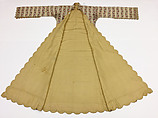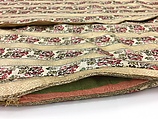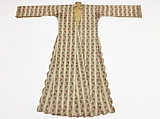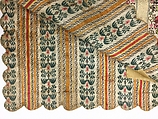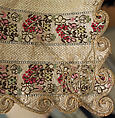Uçetek Entari
Not on view
The entari, or robe, was the main element of women’s dress in the Ottoman Empire, worn together with a chemise, or gömlek, and baggy trousers, or şalvar. Constructed along traditional lines, this Ottoman woman’s entari is made of an elaborately woven silk known as savai, a silk brocade with alternating vertical bands of floral motifs composed of extra weft silk thread and a herringbone design often executed in gold metal-wrapped thread. This particular pattern of broad stripes of flowers alternating with a stripe of lighter silk in a herringbone design, separated by a narrow line of tiny blue and white rectangles, is associated with silk workshops in the Istanbul neighborhood of Üsküdar. The entari has a small stand-up collar, long straight sleeves open until the elbow, and triangular pieces added to both sides of the front for fullness. The skirt is open to the hips and there is a pocket in the side seam just above the side slit on each side. The sleeves are lined with a rather coarsely woven, colorful striped fabric as far as the elbows, and the pockets have a narrow facing of a green and pink striped silk. At some point, the entire garment was relined with a gold-colored fabric and modern snaps were added at the bodice. All of the edges of the entari have been finished in a neat, scalloped design and narrow gold-wrapped braid, a restrained ornamentation which allows the highly decorative fabric to take center stage in this elegant robe.
Due to rights restrictions, this image cannot be enlarged, viewed at full screen, or downloaded.
This artwork is meant to be viewed from right to left. Scroll left to view more.



